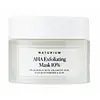What's inside
What's inside
 Key Ingredients
Key Ingredients

 Benefits
Benefits

 Concerns
Concerns

 Ingredients Side-by-side
Ingredients Side-by-side

Water
Skin ConditioningPumice
AbrasiveGlycolic Acid
BufferingStearic Acid
CleansingCetearyl Alcohol
EmollientCI 77891
Cosmetic ColorantSodium Hydroxide
BufferingJojoba Esters
EmollientGluconolactone
Skin ConditioningGlycerin
HumectantSodium Cocoyl Isethionate
CleansingDimethicone
EmollientSalicylic Acid
MaskingSimmondsia Chinensis Seed Oil
EmollientSqualane
EmollientSodium Hyaluronate
HumectantLeuconostoc/Radish Root Ferment Filtrate
AntimicrobialBisabolol
MaskingC12-15 Alkyl Benzoate
AntimicrobialHippophae Rhamnoides Fruit/Seed Oil
AntimicrobialNiacinamide
SmoothingRosa Canina Fruit Oil
EmollientCamellia Sinensis Leaf Extract
AntimicrobialGlycyrrhiza Glabra Root Extract
BleachingGlycine Soja Oil
EmollientSteareth-20
CleansingXanthan Gum
EmulsifyingSteareth-21
CleansingPhenoxyethanol
PreservativeEthylhexylglycerin
Skin ConditioningTetrasodium Glutamate Diacetate
Tocopherol
AntioxidantWater, Pumice, Glycolic Acid, Stearic Acid, Cetearyl Alcohol, CI 77891, Sodium Hydroxide, Jojoba Esters, Gluconolactone, Glycerin, Sodium Cocoyl Isethionate, Dimethicone, Salicylic Acid, Simmondsia Chinensis Seed Oil, Squalane, Sodium Hyaluronate, Leuconostoc/Radish Root Ferment Filtrate, Bisabolol, C12-15 Alkyl Benzoate, Hippophae Rhamnoides Fruit/Seed Oil, Niacinamide, Rosa Canina Fruit Oil, Camellia Sinensis Leaf Extract, Glycyrrhiza Glabra Root Extract, Glycine Soja Oil, Steareth-20, Xanthan Gum, Steareth-21, Phenoxyethanol, Ethylhexylglycerin, Tetrasodium Glutamate Diacetate, Tocopherol
Water
Skin ConditioningKaolin
AbrasiveButylene Glycol
HumectantGlycerin
HumectantBentonite
AbsorbentDicaprylyl Carbonate
EmollientLactic Acid
BufferingGlycolic Acid
BufferingPotassium Hydroxide
BufferingCetearyl Olivate
1,2-Hexanediol
Skin ConditioningSorbitan Olivate
EmulsifyingCellulose Acetate
Glyceryl Stearate
EmollientMaltodextrin
AbsorbentPolyacrylate Crosspolymer-6
Emulsion StabilisingAcacia Senegal Gum
MaskingOryza Sativa Powder
Lipase
Skin ConditioningProtease
ExfoliatingBiosaccharide Gum-1
HumectantT-Butyl Alcohol
PerfumingSodium Levulinate
Skin ConditioningGlyceryl Caprylate
EmollientSodium Anisate
AntimicrobialSodium Phytate
Tocopherol
AntioxidantWater, Kaolin, Butylene Glycol, Glycerin, Bentonite, Dicaprylyl Carbonate, Lactic Acid, Glycolic Acid, Potassium Hydroxide, Cetearyl Olivate, 1,2-Hexanediol, Sorbitan Olivate, Cellulose Acetate, Glyceryl Stearate, Maltodextrin, Polyacrylate Crosspolymer-6, Acacia Senegal Gum, Oryza Sativa Powder, Lipase, Protease, Biosaccharide Gum-1, T-Butyl Alcohol, Sodium Levulinate, Glyceryl Caprylate, Sodium Anisate, Sodium Phytate, Tocopherol
 Reviews
Reviews

Ingredients Explained
These ingredients are found in both products.
Ingredients higher up in an ingredient list are typically present in a larger amount.
Glycerin is already naturally found in your skin. It helps moisturize and protect your skin.
A study from 2016 found glycerin to be more effective as a humectant than AHAs and hyaluronic acid.
As a humectant, it helps the skin stay hydrated by pulling moisture to your skin. The low molecular weight of glycerin allows it to pull moisture into the deeper layers of your skin.
Hydrated skin improves your skin barrier; Your skin barrier helps protect against irritants and bacteria.
Glycerin has also been found to have antimicrobial and antiviral properties. Due to these properties, glycerin is often used in wound and burn treatments.
In cosmetics, glycerin is usually derived from plants such as soybean or palm. However, it can also be sourced from animals, such as tallow or animal fat.
This ingredient is organic, colorless, odorless, and non-toxic.
Glycerin is the name for this ingredient in American English. British English uses Glycerol/Glycerine.
Learn more about GlycerinGlycolic Acid is arguably the most famous alpha hydroxy acid (AHA) with tons of research backing its benefits.
It is found naturally in sugar cane but the form used in skincare is usually synthetic for purity and stability.
Glycolic acid removes the top layer of dead skin cells to allow newer and fresher ones to emerge.
AHAs work by breaking down the structural “glue” that holds old skin cells in place. When that buildup is gone, your skin can renew itself more efficiently.
Research also shows glycolic acid stimulates collagen production, helping to firm and thicken the skin over time. This is one of its biggest advantages over other AHAs.
Overall, glycolic acid helps with:
Fun fact: Glycolic acid boosts skin hydration by helping it produce molecules that increase hyaluronic acid naturally.
To work best, glycolic acid products should have a pH between 3-4 (that’s where exfoliation is most effective but still gentle on skin).
The pH and concentration of a product are key to its effectiveness:
It is normal to feel a slight stinging sensation when using glycolic acid. This usually fades as your skin adjusts.
Because glycolic acid has the smallest molecular size in the AHA family, it can penetrate deeper, which enhances its effectiveness but also makes it more likely to irritate sensitive skin.
If your skin is very sensitive or prone to rosacea, glycolic acid may be too strong; in that case, try milder options like lactic acid or a PHA instead.
Recent studies suggest glycolic acid might even help protect against UV damage. But don’t skip sunscreen! Freshly exfoliated skin is more sensitive to the sun.
Glycolic acid is a skincare superstar. It smooths, brightens, hydrates, and firms the skin. Unless you’re highly sensitive, it’s well worth adding to your routine.
Read more about some other popular AHA's here:
Learn more about Glycolic AcidTocopherol (also known as Vitamin E) is a common antioxidant used to help protect the skin from free-radicals and strengthen the skin barrier. It's also fat soluble - this means our skin is great at absorbing it.
Vitamin E also helps keep your natural skin lipids healthy. Your lipid skin barrier naturally consists of lipids, ceramides, and fatty acids. Vitamin E offers extra protection for your skin’s lipid barrier, keeping your skin healthy and nourished.
Another benefit is a bit of UV protection. Vitamin E helps reduce the damage caused by UVB rays. (It should not replace your sunscreen). Combining it with Vitamin C can decrease sunburned cells and hyperpigmentation after UV exposure.
You might have noticed Vitamin E + C often paired together. This is because it is great at stabilizing Vitamin C. Using the two together helps increase the effectiveness of both ingredients.
There are often claims that Vitamin E can reduce/prevent scarring, but these claims haven't been confirmed by scientific research.
Learn more about TocopherolWater. It's the most common cosmetic ingredient of all. You'll usually see it at the top of ingredient lists, meaning that it makes up the largest part of the product.
So why is it so popular? Water most often acts as a solvent - this means that it helps dissolve other ingredients into the formulation.
You'll also recognize water as that liquid we all need to stay alive. If you see this, drink a glass of water. Stay hydrated!
Learn more about Water